Distringtrpar.xyz ads (fake) - Free Guide
Distringtrpar.xyz ads Removal Guide
What is Distringtrpar.xyz ads?
Distringtrpar.xyz shows fake messages to convince visitors to allow push notifications to be shown
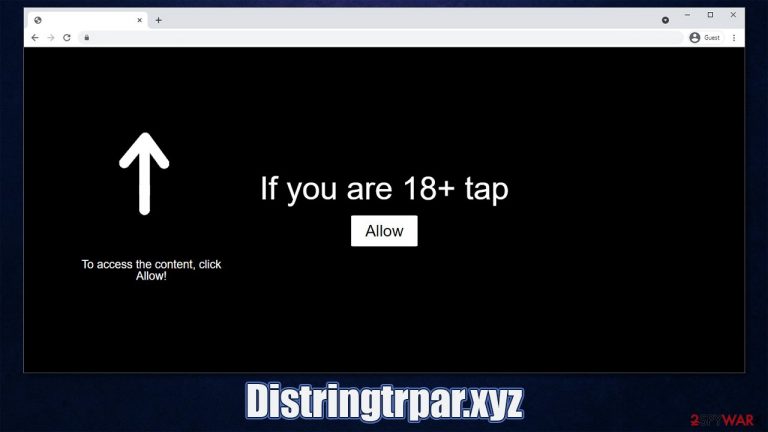
Distringtrpar.xyz ads may show up on your desktop regardless of what you are currently doing on your PC – watching a video, browsing your favorite websites, or streaming. The notifications show up at the top of all the other currently running apps, usually at the bottom or top right corner of the screen, which can be particularly intrusive.
This behavior has been a mystery to many users, as it seems like Distringtrpar.xyz pop-ups are not triggered by something in particular, and can show up at any time. In reality, the reason for this activity is related to users allowing the notifications to be shown from the website in the first place, be it deliberately or not.
In order for the scheme to work, crooks create a website that is essentially an empty shell – it does not have anything of value. People are usually lured to it by clicking on a link on a malicious website or are rerouted automatically by scripts or even adware installed on their systems.
As soon as they enter the site, they are shown a misleading message which actively tells them to click the “Allow” button within the notification prompt – it shows up at the top-left corner of the browser tab. The message usually claims that users need to bypass captcha-like security in order to proceed or that there is additional content for them to view.
As previously mentioned, Distringtrpar.xyz is completely fake, and it does not have any value whatsoever. Without knowing this, gullible users might be convinced to click “Allow,” which would automatically grant the website permission to deliver information to users' screens directly. Likewise, users might click buttons unintentionally after being redirected several times from somewhere else.
If you have fallen victim to this scam or clicked the link accidentally, you shouldn't be worried too much, as this permission can easily be removed as easily as it was granted; all you need to do is access the browser settings. We explain how to do this below. Also, we'll provide additional security tips for a better and more secure browsing experience.
| Name | Distringtrpar.xyz |
| Type | Push notifications, ads, pop-ups, scam |
| Distribution | Misleading statements are made in order to make users click the “Allow” button within the notification prompt |
| Symptoms | Push notifications that include misleading information links would show up on the desktop at random times |
| Risks | Installation of potentially unwanted programs or malware, data loss, information leak, financial losses due to encountered scams |
| Termination | You can stop the intrusive notifications by accessing web browser settings, as explained in the instructions below. If you suspect adware infection, you should scan your machine with SpyHunter 5Combo Cleaner system security software |
| Recovery | Cleaning web browsers is just as important when dealing with potentially unwanted programs. You can do that manually as per instructions or use an automatic solution FortectIntego |
The dangers of online scams
There are a lot of misconceptions when it comes to push notifications. Those who start receiving the intrusive pop-ups might initially believe that their systems have been infected with a virus. However, as soon as they scan their computers, nothing is usually found. Even if there is, it does not prevent the pop-ups from showing up repeatedly after the scan.
This is because the push notification feature has nothing to do with a computer infection, at least not directly. It is commonly used by various legitimate websites to send information to those who desire to receive it. For example, by allowing push notifications from Facebook, you'd allow the messages or other important information to be shown to you within a pop-up message, even if you are not currently visiting the social network itself.
However, it did not take long for crooks to realize that it can be used for malicious purposes, hence the appearance of websites such as Distringtrpar.xyz, Rategeisteryc.xyz, or Brainychoose-captcha.top, and many others. In fact, there are so many of them that they simply keep getting recreated under different names, and there's little to no difference when it comes to sites' functions.
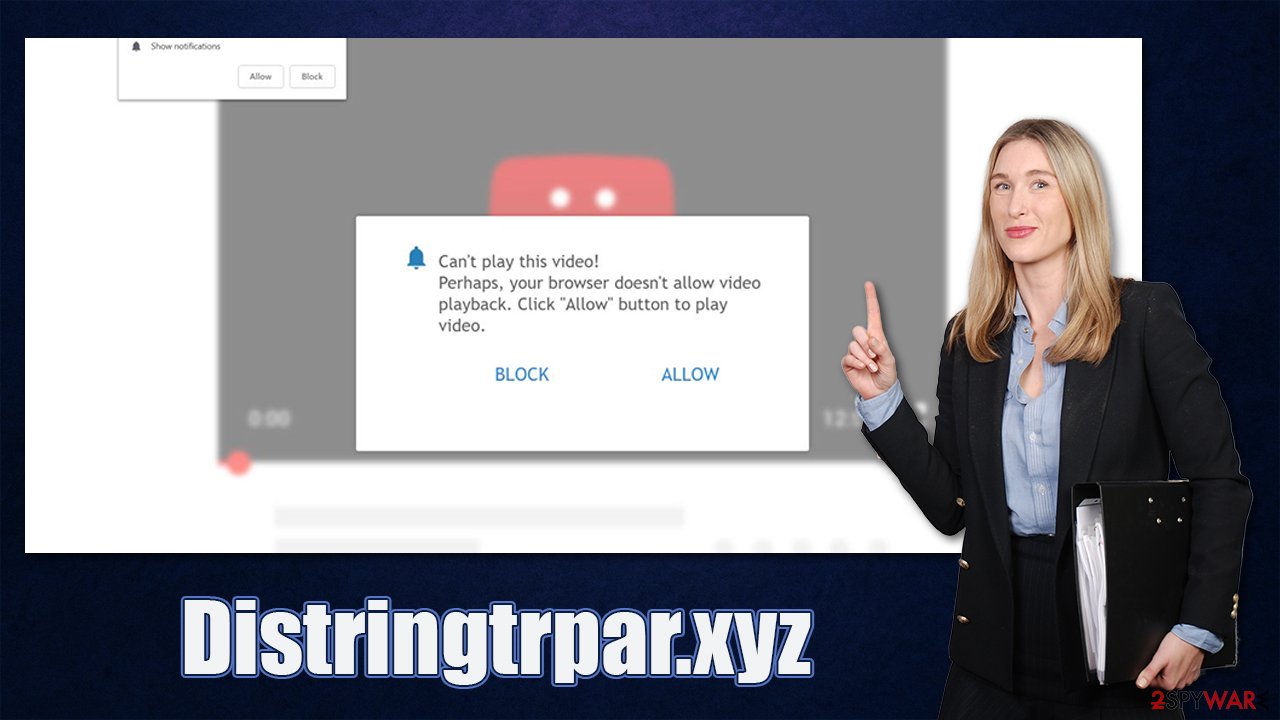
Possibly the most dangerous issues that arise from Distringtrpar.xyz notifications are the links embedded within. They might commonly offer users to remove allegedly found viruses from the system with a special removal tool or promise to earn money quickly for a quick initial investment. Other times, they might be offered to reclaim an allegedly won prize, and all they need to do is provide their personal information.
Please do not treat these notifications as something legitimate, as they are all fake and might lead to the installation of malware, monetary loss, or personal information disclosure to cybercriminals. If you have indeed done that, you should immediately scan your computer with SpyHunter 5Combo Cleaner, Malwarebytes, or another security software to ensure no malicious programs are running in the background.
Access browser settings to remove Distringtrpar.xyz notifications
As previously noted, cybersecurity software won't remove push notifications that show up on your screen randomly. You can, however, easily prevent the website from showing you these pup-ups by accessing the site permission section within your web browser settings. Keep in mind that these instructions can be used for any other website out there, so if you ever get tricked again or allow notifications by accident, you can undo this decision in a similar manner.
Google Chrome (desktop):
- Open Google Chrome browser and go to Menu > Settings.
- Scroll down and click on Advanced.
- Locate the Privacy and security section and pick Site Settings > Notifications.
- Look at the Allow section and look for a suspicious URL.
- Click the three vertical dots next to it and pick Block. This should remove unwanted notifications from Google Chrome.
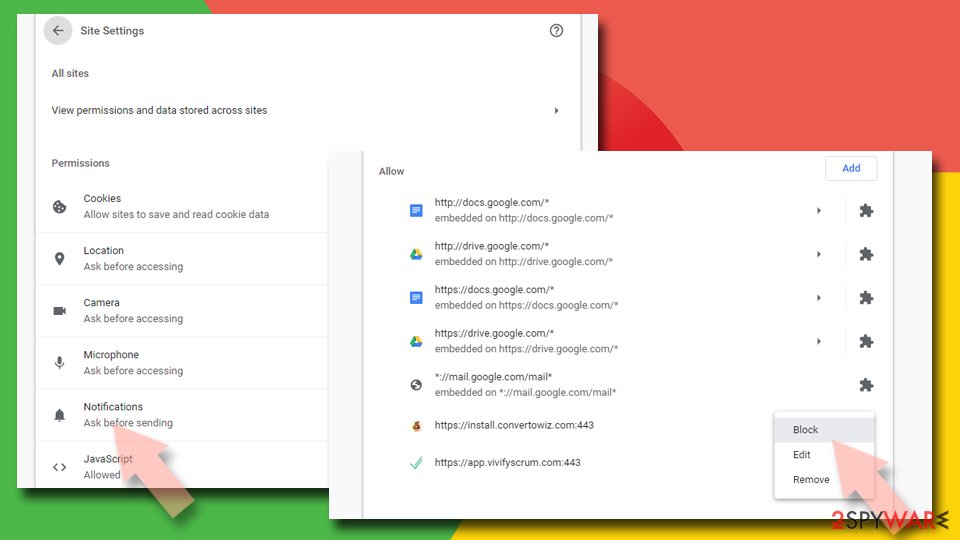
Google Chrome (Android):
- Open Google Chrome and tap on Settings (three vertical dots).
- Select Notifications.
- Scroll down to the Sites section.
- Locate the unwanted URL and toggle the button to the left (Off setting).
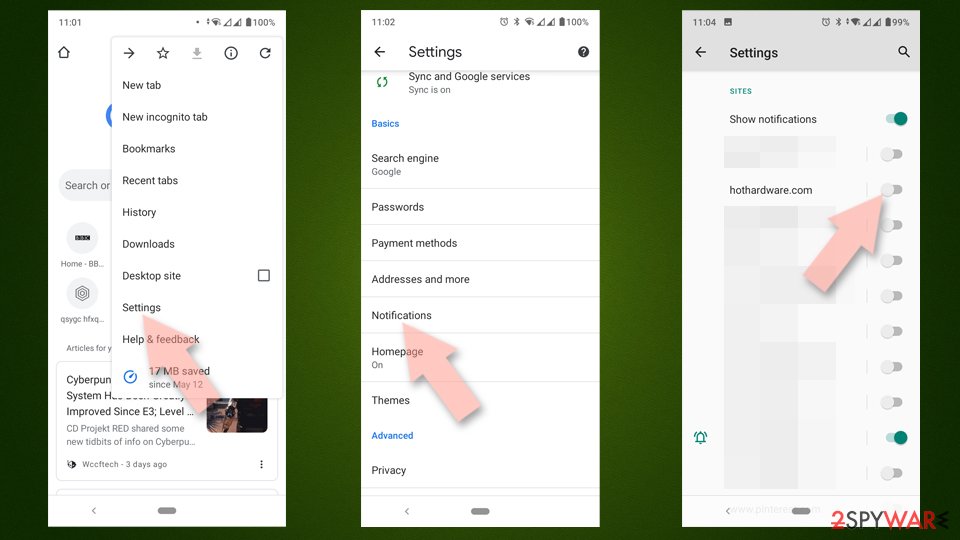
Mozilla Firefox:
- Open Mozilla Firefox and go to Menu > Options.
- Click on Privacy & Security section.
- Under Permissions, you should be able to see Notifications. Click the Settings button next to it.
- In the Settings – Notification Permissions window, click on the drop-down menu by the URL in question.
- Select Block and then click on Save Changes. This should remove unwanted notifications from Mozilla Firefox.
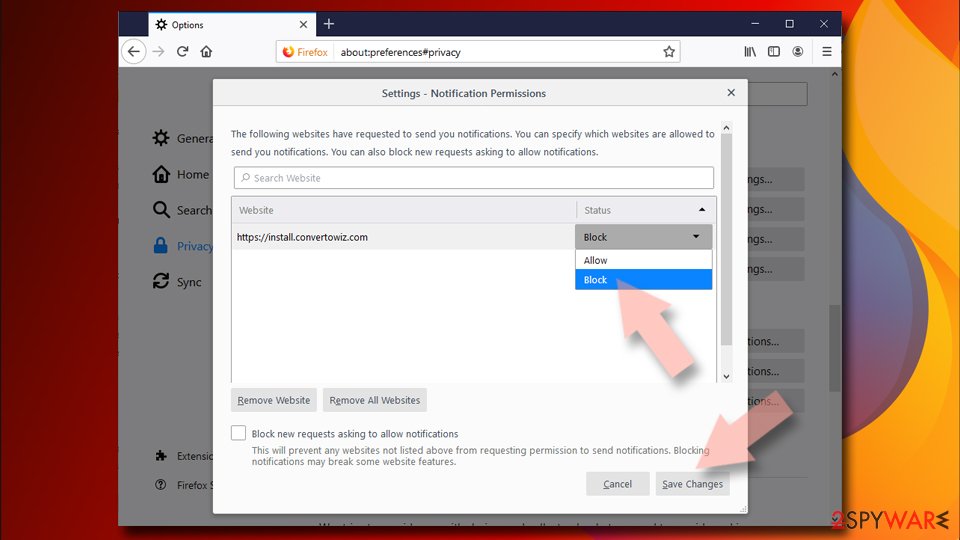
MS Edge (Chromium):
- Open Microsoft Edge, and go to Settings.
- Select Site permissions.
- Go to Notifications on the right.
- Under Allow, you will find the unwanted entry.
- Click on More actions and select Block.
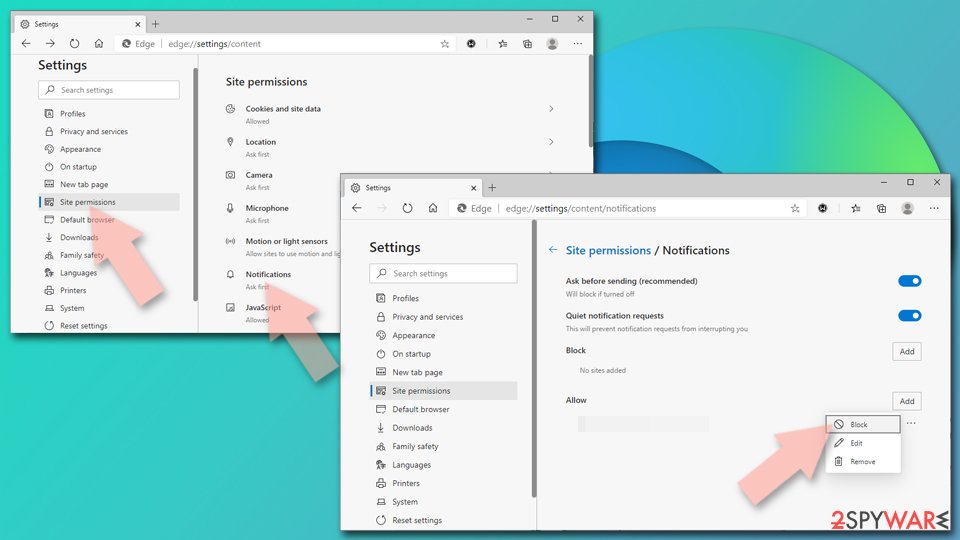
Safari:
- Click on Safari > Preferences…
- Go to the Websites tab and, under General, select Notifications.
- Select the web address in question, click the drop-down menu and select Deny.
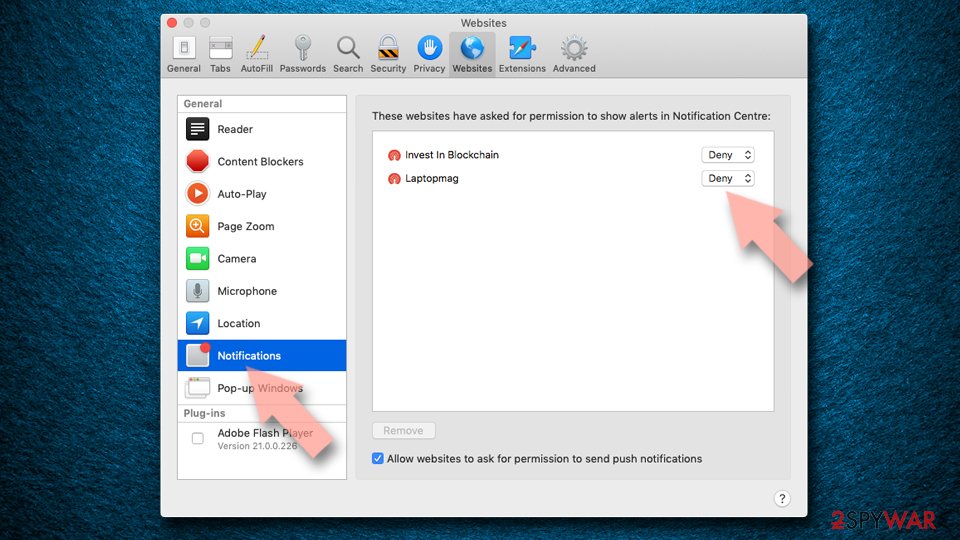
Additional security tips
Internet, while relatively young in comparison to other technologies, has become a part of everyone's lives. With around 1.7 billion websites[1] in existence, it is unavoidable that some of them could be hacked, created by hackers, or used as places where malware is hosted.
Thanks to various security regulations implemented by various authorities and tech giants responsible for providing users access to the internet, the situation drastically improved, and malicious activity is much lower than it used to be. Despite this, there are still thousands of websites created for malicious purposes daily, so you should never forget that and keep in mind that you can't be 100% safe all the time.
Therefore, you should be aware of the online dangers and make sure that you don't get tricked by online scams in the future. Here are a few security tips from experts at novirus.uk:[2]
- Always check the URL of the website you are visiting – it can quickly point at deception;
- Never open MS Office documents from emails that ask to enable macro[3] function;
- Do not download software or even visit websites that distribute illegal program installers/cracks;
- The “Allow” button within the notification prompt would always do one thing – it can't be used for verification or any other purposes;
- When installing new software, always pick Advanced or Custom installation settings to stay in control of the installation process;
- Use strong passwords for all your accounts and never reuse them; use a password manager;
- Employ tools that could help you defend yourself from online attacks – antivirus software, ad-blockers, and VPN.
Additionally, frequent redirects to malicious websites could indicate the infection of adware or another malicious program. If you know which application could be causing an increased number of ads and redirects, you can uninstall it manually, although using anti-malware software is highly recommended. Likewise, you should take your time and clean your web browsers to prevent further data tracking and continuous feed of ads.
If you want to do this quicker, you should employ FortectIntego maintenance and repair utility to clean your browsers with just one button click and check your system for corruption. Alternatively, use the instructions below to do this manually. Note that a browser reset would be a better choice in some cases, but it all depends on what type of infection was hiding on your device.
Getting rid of Distringtrpar.xyz ads. Follow these steps
Remove from Google Chrome
Delete malicious extensions from Google Chrome:
- Open Google Chrome, click on the Menu (three vertical dots at the top-right corner) and select More tools > Extensions.
- In the newly opened window, you will see all the installed extensions. Uninstall all the suspicious plugins that might be related to the unwanted program by clicking Remove.

Clear cache and web data from Chrome:
- Click on Menu and pick Settings.
- Under Privacy and security, select Clear browsing data.
- Select Browsing history, Cookies and other site data, as well as Cached images and files.
- Click Clear data.

Change your homepage:
- Click menu and choose Settings.
- Look for a suspicious site in the On startup section.
- Click on Open a specific or set of pages and click on three dots to find the Remove option.
Reset Google Chrome:
If the previous methods did not help you, reset Google Chrome to eliminate all the unwanted components:
- Click on Menu and select Settings.
- In the Settings, scroll down and click Advanced.
- Scroll down and locate Reset and clean up section.
- Now click Restore settings to their original defaults.
- Confirm with Reset settings.

Remove from Mozilla Firefox (FF)
Remove dangerous extensions:
- Open Mozilla Firefox browser and click on the Menu (three horizontal lines at the top-right of the window).
- Select Add-ons.
- In here, select unwanted plugin and click Remove.

Reset the homepage:
- Click three horizontal lines at the top right corner to open the menu.
- Choose Options.
- Under Home options, enter your preferred site that will open every time you newly open the Mozilla Firefox.
Clear cookies and site data:
- Click Menu and pick Settings.
- Go to Privacy & Security section.
- Scroll down to locate Cookies and Site Data.
- Click on Clear Data…
- Select Cookies and Site Data, as well as Cached Web Content and press Clear.

Reset Mozilla Firefox
If clearing the browser as explained above did not help, reset Mozilla Firefox:
- Open Mozilla Firefox browser and click the Menu.
- Go to Help and then choose Troubleshooting Information.

- Under Give Firefox a tune up section, click on Refresh Firefox…
- Once the pop-up shows up, confirm the action by pressing on Refresh Firefox.

Remove from Microsoft Edge
Delete unwanted extensions from MS Edge:
- Select Menu (three horizontal dots at the top-right of the browser window) and pick Extensions.
- From the list, pick the extension and click on the Gear icon.
- Click on Uninstall at the bottom.

Clear cookies and other browser data:
- Click on the Menu (three horizontal dots at the top-right of the browser window) and select Privacy & security.
- Under Clear browsing data, pick Choose what to clear.
- Select everything (apart from passwords, although you might want to include Media licenses as well, if applicable) and click on Clear.

Restore new tab and homepage settings:
- Click the menu icon and choose Settings.
- Then find On startup section.
- Click Disable if you found any suspicious domain.
Reset MS Edge if the above steps did not work:
- Press on Ctrl + Shift + Esc to open Task Manager.
- Click on More details arrow at the bottom of the window.
- Select Details tab.
- Now scroll down and locate every entry with Microsoft Edge name in it. Right-click on each of them and select End Task to stop MS Edge from running.

If this solution failed to help you, you need to use an advanced Edge reset method. Note that you need to backup your data before proceeding.
- Find the following folder on your computer: C:\\Users\\%username%\\AppData\\Local\\Packages\\Microsoft.MicrosoftEdge_8wekyb3d8bbwe.
- Press Ctrl + A on your keyboard to select all folders.
- Right-click on them and pick Delete

- Now right-click on the Start button and pick Windows PowerShell (Admin).
- When the new window opens, copy and paste the following command, and then press Enter:
Get-AppXPackage -AllUsers -Name Microsoft.MicrosoftEdge | Foreach {Add-AppxPackage -DisableDevelopmentMode -Register “$($_.InstallLocation)\\AppXManifest.xml” -Verbose

Instructions for Chromium-based Edge
Delete extensions from MS Edge (Chromium):
- Open Edge and click select Settings > Extensions.
- Delete unwanted extensions by clicking Remove.

Clear cache and site data:
- Click on Menu and go to Settings.
- Select Privacy, search and services.
- Under Clear browsing data, pick Choose what to clear.
- Under Time range, pick All time.
- Select Clear now.

Reset Chromium-based MS Edge:
- Click on Menu and select Settings.
- On the left side, pick Reset settings.
- Select Restore settings to their default values.
- Confirm with Reset.

Delete from Safari
Remove unwanted extensions from Safari:
- Click Safari > Preferences…
- In the new window, pick Extensions.
- Select the unwanted extension and select Uninstall.

Clear cookies and other website data from Safari:
- Click Safari > Clear History…
- From the drop-down menu under Clear, pick all history.
- Confirm with Clear History.

Reset Safari if the above-mentioned steps did not help you:
- Click Safari > Preferences…
- Go to Advanced tab.
- Tick the Show Develop menu in menu bar.
- From the menu bar, click Develop, and then select Empty Caches.

How to prevent from getting adware
Choose a proper web browser and improve your safety with a VPN tool
Online spying has got momentum in recent years and people are getting more and more interested in how to protect their privacy online. One of the basic means to add a layer of security – choose the most private and secure web browser. Although web browsers can't grant full privacy protection and security, some of them are much better at sandboxing, HTTPS upgrading, active content blocking, tracking blocking, phishing protection, and similar privacy-oriented features. However, if you want true anonymity, we suggest you employ a powerful Private Internet Access VPN – it can encrypt all the traffic that comes and goes out of your computer, preventing tracking completely.
Lost your files? Use data recovery software
While some files located on any computer are replaceable or useless, others can be extremely valuable. Family photos, work documents, school projects – these are types of files that we don't want to lose. Unfortunately, there are many ways how unexpected data loss can occur: power cuts, Blue Screen of Death errors, hardware failures, crypto-malware attack, or even accidental deletion.
To ensure that all the files remain intact, you should prepare regular data backups. You can choose cloud-based or physical copies you could restore from later in case of a disaster. If your backups were lost as well or you never bothered to prepare any, Data Recovery Pro can be your only hope to retrieve your invaluable files.
- ^ How Many Websites Are There?. Websitesetup. Free resource for helping beginners to build, manage and grow their websites.
- ^ Novirus.uk. Novirus. Cybersecurity news and malware removal guides.
- ^ Macro virus. Wikipedia. The free encyclopedia.
